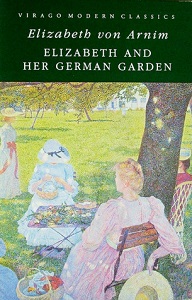
Here is light summer reading, in which the main attraction is Elizabeth’s delight in her garden. Billed as a novel, the text reads as a year of journal entries by Elizabeth, and the situation follows von Arnim’s life situation as wife of a German baron. She was born Mary Annette Beauchamp (later changing her name to Elizabeth) in Australia and raised in England. She describes convincing her husband to spend more time in their country estate, which had been neglected for 25 years. There was no garden left, and she had no experience as a gardener but was eager to have one. The book describes her efforts and failures and renewed efforts, particularly with roses but with many other plants as well, flowers, bushes, and trees. Patience and failure, she says, are the lot of the gardener. The garden becomes her place of refuge and delight, as she spends most of her days outdoors.
The reader will need to return to the world of Downton Abbey, except that the point of view is restricted to the upstairs, not the downstairs. There is much talk of problems with cooks, maids, and, of course, gardeners. Von Arnim writes with a light touch and includes many set pieces such as sleighing to church wrapped in furs, and Christmas with the children, especially the staff children.
Most frustrating for her is that she can’t do the gardening herself. A baroness must not garden. She must hire gardeners and tell them what to do, not an easy task. Once she sneaks out when no one is looking and digs a little. Her work, then, consists of ordering seeds and supervising. But she loves being in the garden as it develops, and resists going to town, much to the amazement of German women visitors, who think city life is far superior (as in Jane Austen novels). Her husband, known to us only as “the Man of Wrath,” does not seem wrathful, just scornful of women, whom he regards as children. Elizabeth does not contest with him, she just acts independently. He does not approve of large expenses for gardens, so she buys seeds with her “pin money” and frets that she may have to cut back ordering dresses for herself.
The reader won’t learn how to plant a garden from this book but will have fun seeing Elizabeth’s grow and sharing her pleasure.